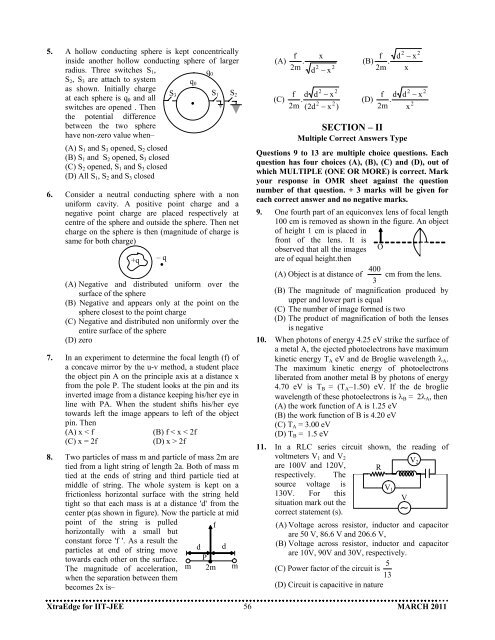March 2011 - Career Point
March 2011 - Career Point
March 2011 - Career Point
Create successful ePaper yourself
Turn your PDF publications into a flip-book with our unique Google optimized e-Paper software.
5. A hollow conducting sphere is kept concentrically<br />
f x<br />
f d<br />
2<br />
− x<br />
inside another hollow conducting sphere of larger (A) .<br />
(B) .<br />
radius. Three switches S 1 ,<br />
2m 2 2<br />
d − x<br />
2m x<br />
q 0<br />
S 2 , S 3 are attach to system q 0<br />
as shown. Initially charge<br />
S<br />
2 2<br />
2 2<br />
at each sphere is q 0 and all 3 S 1 S 2 f d d − x<br />
f d d − x<br />
(C) .<br />
(D) .<br />
2 2<br />
2<br />
switches are opened . Then<br />
2m (2d − x ) 2m x<br />
the potential difference<br />
between the two sphere<br />
SECTION – II<br />
have non-zero value when–<br />
Multiple Correct Answers Type<br />
(A) S 1 and S 3 opened, S 2 closed<br />
Questions 9 to 13 are multiple choice questions. Each<br />
(B) S 1 and S 2 opened, S 3 closed<br />
question has four choices (A), (B), (C) and (D), out of<br />
(C) S 2 opened, S 1 and S 3 closed<br />
which MULTIPLE (ONE OR MORE) is correct. Mark<br />
(D) All S 1 , S 2 and S 3 closed<br />
your response in OMR sheet against the question<br />
6.<br />
number of that question. + 3 marks will be given for<br />
Consider a neutral conducting sphere with a non<br />
each correct answer and no negative marks.<br />
uniform cavity. A positive point charge and a<br />
negative point charge are placed respectively at<br />
centre of the sphere and outside the sphere. Then net<br />
charge on the sphere is then (magnitude of charge is<br />
9. One fourth part of an equiconvex lens of focal length<br />
100 cm is removed as shown in the figure. An object<br />
of height 1 cm is placed in<br />
same for both charge)<br />
front of the lens. It is<br />
observed that all the images O<br />
+q – q<br />
are of equal height.then<br />
400<br />
(A) Object is at distance of cm from the lens.<br />
(A) Negative and distributed uniform over the<br />
3<br />
surface of the sphere<br />
(B) The magnitude of magnification produced by<br />
(B) Negative and appears only at the point on the<br />
upper and lower part is equal<br />
sphere closest to the point charge<br />
(C) The number of image formed is two<br />
(C) Negative and distributed non uniformly over the (D) The product of magnification of both the lenses<br />
entire surface of the sphere<br />
is negative<br />
(D) zero<br />
10. When photons of energy 4.25 eV strike the surface of<br />
a metal A, the ejected photoelectrons have maximum<br />
7. In an experiment to determine the focal length (f) of kinetic energy T A eV and de Broglie wavelength λ A .<br />
a concave mirror by the u-v method, a student place The maximum kinetic energy of photoelectrons<br />
the object pin A on the principle axis at a distance x liberated from another metal B by photons of energy<br />
from the pole P. The student looks at the pin and its 4.70 eV is T B = (T A –1.50) eV. If the de broglie<br />
inverted image from a distance keeping his/her eye in wavelength of these photoelectrons is λ B = 2λ A , then<br />
line with PA. When the student shifts his/her eye (A) the work function of A is 1.25 eV<br />
towards left the image appears to left of the object (B) the work function of B is 4.20 eV<br />
pin. Then<br />
(C) T A = 3.00 eV<br />
(A) x < f<br />
(B) f < x < 2f<br />
(D) T B = 1.5 eV<br />
(C) x = 2f<br />
(D) x > 2f<br />
11. In a RLC series circuit shown, the reading of<br />
8. Two particles of mass m and particle of mass 2m are voltmeters V 1 and V 2<br />
V 2<br />
tied from a light string of length 2a. Both of mass m are 100V and 120V, R<br />
tied at the ends of string and third particle tied at respectively. The<br />
middle of string. The whole system is kept on a source voltage is<br />
V 1<br />
frictionless horizontal surface with the string held 130V. For this<br />
tight so that each mass is at a distance 'd' from the situation mark out the<br />
V<br />
center p(as shown in figure). Now the particle at mid correct statement (s).<br />
point of the string is pulled<br />
horizontally with a small but<br />
constant force 'f '. As a result the<br />
particles at end of string move<br />
towards each other on the surface.<br />
The magnitude of acceleration,<br />
when the separation between them<br />
becomes 2x is–<br />
m<br />
d<br />
f<br />
P<br />
2m<br />
d<br />
m<br />
(A) Voltage across resistor, inductor and capacitor<br />
are 50 V, 86.6 V and 206.6 V,<br />
(B) Voltage across resistor, inductor and capacitor<br />
are 10V, 90V and 30V, respectively.<br />
(C) Power factor of the circuit is 13<br />
5<br />
(D) Circuit is capacitive in nature<br />
XtraEdge for IIT-JEE 56<br />
MARCH <strong>2011</strong>

















